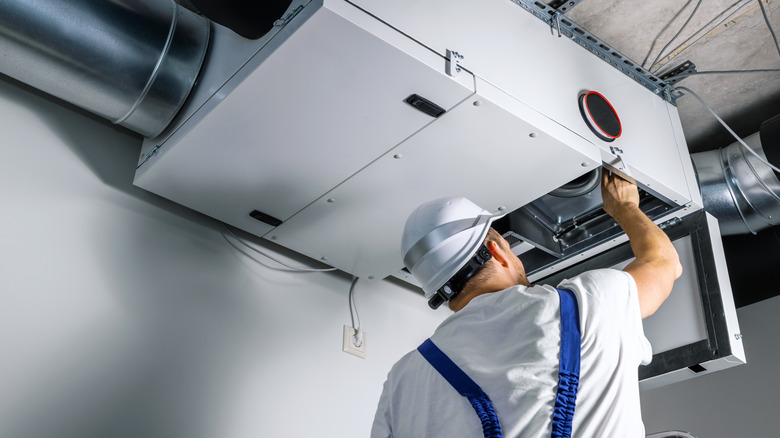Mike Holmes On Why Your Home Feels Stuffy And The Best Way To Solve It
We may receive a commission on purchases made from links.
Have you ever noticed your house having a heavy and uncomfortable feeling, as if there's a damp veil following you around? Maybe it's accompanied by a particularly musty or unpleasant odor, making it hard to breathe at times. There are many different reasons why your house might feel stuffy, and as professional contractor and HGTV host Mike Holmes puts it, stuffy air in your home might be caused by stale air getting trapped inside. The good news is that, according to Holmes, there's a simple fix for when your home starts to get this way, and it starts with your ventilation system.
The feeling of thick air in your home can be more noticeable during warmer summer months as temperatures rise, but it can happen any time of the year. If you live in a newer house, you may notice your home feels particularly stuffy. This is because modern homes are built with energy efficiency in mind. While this treats high electric bills, it can also impact air filtration, which can cause the air in your home to feel stale and uncomfortably sticky at times. For these reasons, Holmes suggests assessing your home's ventilation system and considering investing in an energy recovery ventilator (ERV) to refresh your home with outdoor air while circulating stale indoor air. Or, if you're house hunting, it's important to learn how to tell if a potential home has proper ventilation.
How ventilation systems make such a difference
Although outdoor air can carry pollution into your home, especially if you live near areas with high pollution (think, freeways or factories), generally, the air from outside has fewer pollutants than indoor air. When air enters your home, over time, it can build up moisture, odors, and air pollutants. This can contribute to a stuffy home with air that feels damp and heavy, which is one reason it's important that there's proper circulation and, if there isn't, why you should consider improving your home's air quality. When you have proper ventilation, such as an ERV, as Holmes suggests, the indoor air is recycled, allowing clean outdoor air to enter the home and indoor pollutants to exit, thereby reducing the amount of indoor air pollution.
ERVs typically have five components: ductwork, fans, a filter, a heat exchanger, and system controls. They recycle air by first extracting old air from inside your home (such as basements, bathrooms, and other potentially stuffy areas in your house) along with fresh outdoor air. The two airstreams are then passed through a heat exchanger, bringing the outdoor air to the temperature of the indoor air. The conditioned outdoor air is pumped into the house while the old air is flushed outside.
Natural ventilation, such as opening windows and doors, can help circulate clean air into your home while removing trapped pollutants and odors, a benefit of airing out your home, but it can also be used in tandem with mechanical ventilation systems. Open windows or not, ERVs can circulate fresh air without disrupting the comfort inside your home. Plus, it can keep energy costs low.
Why better air matters so much
Having better air quality inside your home is a no-brainer. Poor indoor air quality can be the source of a stuffy and uncomfortable home, which can also cause decreased cognitive performance. More severely, poor indoor air quality can also negatively impact your health in the form of respiratory issues and other health concerns, as well as making it easier for airborne diseases to spread throughout your home. The health risks of long-term exposure to indoor pollutants can prompt mild to severe respiratory problems, causing headaches, fatigue, and eye or throat irritation. If you or members of your household have allergies or asthma, for example, bad indoor air quality can worsen those symptoms. This is because pollutants, such as pollen, pet dander, and mold spores, grow in damp environments and can become trapped in your home if there isn't proper ventilation.
Clean air is essential to your health, well-being, comfort, and even productivity. According to some studies, it can improve cognitive function, allowing for more improved concentration and mental clarity, making it easier for you to work, study, and feel comfortable during leisure activities in your home. The quality of your indoor air can also be the difference between restlessness and a good night's sleep, since the heaviness of bad air can disturb your sleep.
If you're convinced of the merits of an ERV, buying one isn't "cheap," but it's not a purchase that will break the bank. You can get a single-room unit for around $250, or you can buy one that integrates into your existing HVAC system starting around $1,000.


